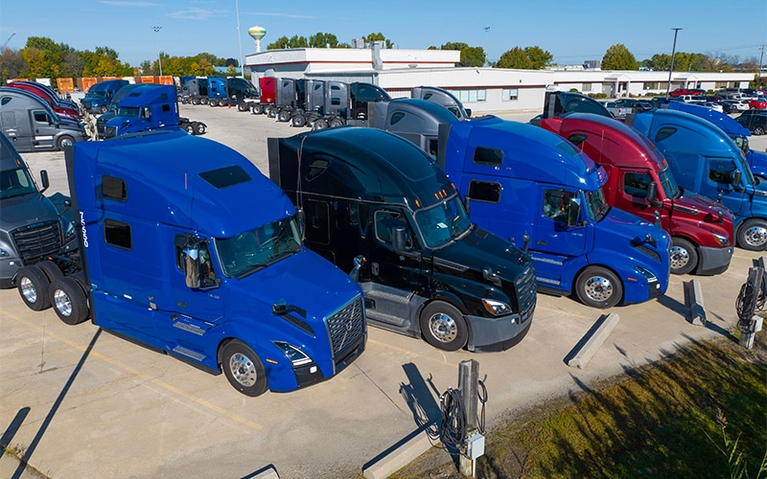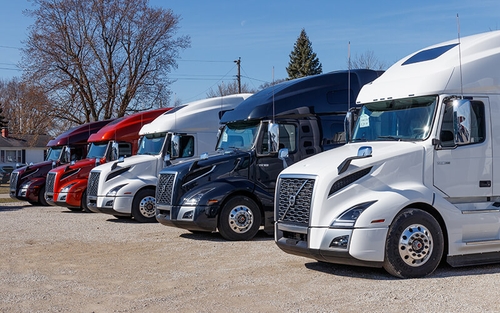How to buy a semi-truck: Costs, needs and considerations
February 28, 2024

Estimated reading time: 4 minutes
Whether you’re an experienced owner-operator or a driver who’s just starting a trucking business, purchasing a semi-truck can be a good investment, so long as you know what to expect and have a solid business plan.
As you research how to buy a semi-truck, the following considerations may help you make an informed business decision.
How much does it cost to buy a semi-truck?
One of the biggest decisions when buying a commercial truck is whether to purchase a new or a used rig for your business.
The following will play a factor in your choice:
- The amount of money you have saved for a down payment.
- How much of a payment your business can afford to pay monthly or weekly.
- How much risk you’re willing to take with potential repairs.
Buying a brand-new truck
A new semi-truck can cost between $175,000-$250,000, depending on the make and model you chose.
Advantages of buying new
- A new truck is usually covered by a warranty.
- A new truck often has less risk of needing repairs.
- A new truck is usually spec’d with the latest features.
Disadvantages of buying new
- A new truck will probably cost more and require more money down.
- A new truck will lose value as soon as it’s driven off the lot.
Buying a used truck
You can generally expect to pay between $20,000 and $115,000 for a used semi-truck.
Advantages of buying used
- A used truck will most likely have smaller monthly payments and require less money down than a new truck.
- A used truck will likely have less strict credit score requirements.
Disadvantages of buying used
- A used truck warranty usually expires earlier and doesn’t cover as much for repairs.
- A used truck may need to be upgraded sooner than a new truck.
What do I need to buy a semi-truck?
What you need to buy a semi-truck varies depending on the company or dealership you purchase a truck from, as well as how your business will pay for or finance the truck.
If you pay for the truck with cash
The truck dealership may require proof that you have a Class A Commercial Driver’s License (CDL). Since you are buying the truck outright and don’t need financing, the vendor won’t need to check your credit score or your previous buying history.
If you finance the truck
The lender you finance through will usually require you to have a down payment, which can range from 1%-40%. The down payment amount varies based on:
- Your credit score.
- How long you’ve had a CDL.
- If you have any commercial lending payment history.
Other financing requirements vary from lender to lender. Some items you may need to provide include, but are not limited to:
- Proof of insurance.
- Business filings.
- Loan approval.
- A Class A CDL.
- Truck information, including the make, model, mileage and condition.
What should I look for when buying a semi-truck?
1. If the cost of the truck fits within your business’ budget.
There’s a good chance sales representatives are going to ask how much you can afford to spend on a truck. Know your answer and commit to it.
2. If the truck meets your business needs.
Go into your purchasing experience with an idea of what you want in a semi-truck. There are many things to consider, including if you want:
- A day cab or sleeper truck.
- A manual or automated transmission.
- A specific make and model of truck.
The type of freight your business hauls and how often you get home will determine what truck you need to get.
3. If the truck fulfills your must-haves.
It’s a good idea to create a list of all the things your truck absolutely cannot go without. Some of the most common things owner-operators find important include:
- The way the truck handles.
- What the truck looks like.
- How the truck rides.
- The MPG of the truck.
- What features the truck comes with (especially safety and cost-saving features).
If you aren’t sure what type of truck is right for your business, we encourage you to do some research and talk to other owner-operators about what trucks they’ve had success with and ones they have not.
4. If the truck has a good history.
If you are purchasing a used truck, it’s always a good idea to run a history check on it.
You can get a holistic view of the truck’s history with information like:
- Accident reports.
- Maintenance schedules.
- Upgrade lists.
- Oil changes.
5. If the truck is in good condition.
If you are buying a used truck, once you confirm the truck’s history, you can assess the semi’s current condition.
Check the:
- Overall appearance of the truck.
- Mileage.
- Sound of the engine.
- If there’s any damage.
Most sellers will let the buyer drive the truck around to see how it rides. Some will even let you take the truck to a mechanic to confirm everything checks out.



